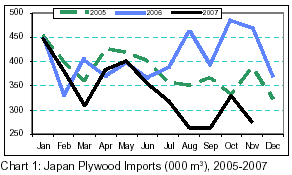|
Japan
Wood Products Prices
Dollar
Exchange Rates of 31th Jan. 2008
Japan
Yen 106.43
Reports
From Japan
Japanese executive sees bright skies for plywood in
2008
The Japan Lumber Journal recently interviewed Tatsuo
Koyanagi, the new general manager of the plywood
department of Japan Kenzai, on trends in the plywood
market for 2007 and the outlook for 2008. Mr. Koyanagi
provided an overview of the supply and demand situation
for plywood, indicating that the amount of imported
plywood from January to December 2007 is likely to be
about 3.95 million m3. He said there was a good balance of
supply and demand for imported plywood by September
2007, but that stock conditions were much different for
domestic plywood, which was in oversupply by about
200,000 m3 in 2007.
For 2008, Mr. Koyanagi said he expected a number of
2007 trends to continue for imported plywood. He
expected Malaysian plywood to be used for foundations
and composite panels. Indonesian plywood would
continue to be used for thin and medium-thick plywood
and Chinese plywood would be utilized as packaging.
Regarding lauan, Koyanagi said that as the volume
received was decreasing in a manner similar to that of
Indonesian plywood, it was likely that lauan would be
used for medium-thick and thin plywood. He noted that if
new orders for imported products arrived, suppliers are
likely to ask for increased prices and the purchasing price
of plywood would increase to cover the higher costs of
adhesives and shipping charges. Finally, he mentioned the
growing market for long softwood plywood in 2008,
which would be used to make housing more earthquake
resistant.
Southsea Lumber Conference notes shipping
problems
In December 2007, the Tokyo chapter of the Japan
Southsea Lumber Conference met to discuss the current
state of the market, reported the Japan Lumber Journal.
The chairperson of the Conference noted that 2007 had
been a ‘troubling year’ for the market and participants
noted the problems associated with transport of Southsea
lumber and logs from Sarawak. One participant explained
the ongoing problems with negotiations associated with
ships belonging to the Southsea Lumber Transport
Agreement (NFA). As a result of the situation, it was
noted that imports had been on only 7-8 ships and reached
about 70,000 m3 per month since October 2007,
representing the lowest imported volume of the year. The
participant also suggested that log importers were
somewhat anxious about being able to provide a stable
supply of logs to plywood manufacturers given the
shipping situation.
Regarding prices, some participants noted that there was a
slump in log prices. Others suggested that the high prices
demanded by suppliers made it difficult to obtain logs
from Malaysia, especially keruing logs. As a result of the
monsoons in Malaysia, prices had been high since cutting
of logs was low.
The total amount of logs received from January to October
2007 was 883,000 m3, a 22% decrease from the same
period in 2006. The amount of Southsea lumber imports
for January to November was 417,800 m3, a 11.8% fall
from the previous year. This drop was attributed to the
significant lack of lauan planks imported. In addition, the
sluggishness of domestic sales was also noted, a trend
which began in midway until the end of 2007.
Plywood imports struggle as production eased in
Malaysia and Indonesia
At the beginning of January, many distributors were
selling plywood at lower prices and plywood movements
continued to be slow, said the Japan Lumber Journal. It
was noted that some producers in Malaysia and Indonesia
reduced plywood production for Japan, since producers
could not cope with the increasing production costs. Some
items were also relatively scarce.
Japan Lumber Reports (JLR) drew attention to the current
weakened state of the market and manufacturers’
pessimistic outlook for the first quarter due to slow
housing starts. Manufacturers are likely to curtail
production of domestic plywood and reduce imports of
plywood through March in order to reduce supply. JLR
indicated that log production in Sarawak and Sabah were
nearly 30% less than previous years and suggested that
there were some difficulties in filling ships with logs.
Regarding price trends, JLR noted the uncertainty
associated with prices for Sarawak meranti logs, since
there was limited demand from Japan. However, kapur
and keruing logs were being actively bought due to
sustained demand from China, which drove up prices for
these species. It was also anticipated that there would be a
further rise in ocean freight rates this year, thereby further
impacting the Southsea log market.
In November 2007, plywood imports dropped 41% from
November 2006 levels. JLR noted that plywood shipments
in November were the lowest in five and a half years.
However, December shipments were expected to be nearly
double those in November.

Housing starts show signs of recovery
Japan Lumber Reports noted a 9.5% rise in housing starts
in November 2007 from the level in the previous month,
even though they represented a 27% fall from the same
period in 2006. The November 2007 starts reached nearly
276,000 and it was speculated that this may reflect the
resolution of problems associated with the revised
Building Standards Act.

|